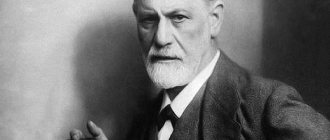06/16/20215 minutes read 463
The foundations of psychoanalysis were formed at the turn of the 19th and 20th centuries. Today, although the concept remains controversial, it has become an important and integral part of modern culture, having a significant influence on philosophy, medicine, religion and culture. Any educated and inquisitive person should have an idea of what psychoanalysis is and understand its basic terms.
The founder of psychoanalytic theory is the Austrian physician Sigmund Freud (1856 - 1939). He was educated at the University of Vienna, did an internship in France, in Berlin, and then went into private practice, working with patients of various ages, trying to find effective ways to treat neuroses, mental disorders and explain their causes.
Long-term and professional continuous practice pushed him to form his own concept, which he repeatedly outlined in his numerous works, talking about what the unconscious is, what role it plays in human life and how to use this knowledge in practical activities in various fields of knowledge.
Initially, S. Freud started from the concept of “catharsis,” which goes back to Aristotle. The essence of the term is that during the emotions that a person experiences, perceiving works of dramatic art, empathizing with the characters, the soul is “cleansed” of everything accumulated over many years.
Therapy based on this concept involved using hypnosis to force a person to remember the emotions they experienced during a traumatic event. This procedure brought relief. But one day Freud came to the conclusion that not all patients are amenable to hypnosis, and this prompted him to search for new techniques of influence. Thus, a method based on free associations soon appeared.
Patients were asked to talk about all the associations and fantasies they had in the process of discussing any issues or interpreting dreams. This made it possible to build hypotheses regarding the origins of the disease. Thus psychoanalytic theory was born.
Quote According to Freud, of all the discoveries that humanity has ever made, three can be identified that have caused significant damage to human narcissism:
1. The cosmological theory of Nicolaus Copernicus, which proved that our planet is not the center of the Universe, but is just one of the planets of a small system. 2. The biological concept of Charles Darwin, according to which man is not a higher power, but is descended from animals as a result of natural selection common to all living beings. 3. Freud's own discovery of the unconscious and its superiority over consciousness.
Theory of psychoanalysis
The theory of psychoanalysis contains philosophical and psychological positions, is a method of studying the human psyche, and is used to diagnose various types of mental illnesses and their treatment.
The central concept of psychoanalysis is the “unconscious,” which underlies human life and guides his actions. Also, his behavior is influenced by various kinds of complexes that form in childhood and “libido” (sexual desire).
The scientist believed that what a person represses from consciousness does not disappear anywhere, but moves into the area of the unconscious and continues to influence future life, emerging under various masks. S. Freud examined in detail the structure of the human psyche and concluded that it consists of three elements:
- I (ego, das Ich),
- Super-ego (super-ego, das Űber Ich),
- It (Id, das Es).
This structure is comparable to an iceberg:
- in which, what is on the surface – superego.
These are conscience, morality, principles, duty, education, framework and norms of behavior established by society.
- The invisible part of the iceberg - unconscious.
These are instincts, suppressed desires, fears, complexes, sexual desire, everything that a person tries to hide from others.
- Ego
is located at the junction of two parts. The ego is the person himself, his personality, which acts depending on which part of him is stronger.
If the unconscious takes over in a certain situation, then a person follows his desires and instincts; if the super-ego takes over, then he acts as is right, as is accepted in society.
If a person succumbs to the unconscious and acts as he wants, and not as he needs, then remorse sets in, a super-ego begins to appear in the person, which, with a feeling of guilt, reminds him that he did wrong. And if an individual infringes on his desires and acts in accordance with duty and moral norms, the suppressed unconscious begins to manifest itself in various forms: dreams, slips of the tongue, slips of the tongue, mistakes, and in some cases manifests itself in the form of neuroses and mental illnesses. The Austrian scientist attached great importance to all errors and slips, believing that they were not accidental and were a manifestation of the unconscious.
One of the central concepts of psychoanalysis is “libido” - these are suppressed sexual instincts that can manifest themselves in something creative - creativity, sports, active social activities, or maybe in something destructive - war, terrorism, murder. Based on this concept, a great scientist, an outstanding athlete and a hired killer are people with a hugely developed libido who have transformed (sublimated) it in a certain direction. That is, sublimation is the direction of unspent sexual energy into some other activity, and the more such energy a person has, the more active he will be and will achieve better results.
As a result of the events of the First World War, S. Freud slightly adjusted his concept and identified two primary principles that manifest themselves both in the individual person and in the existence of society and the cosmos: life (eros) and death (thanatos). These concepts are manifested in the desire for creation and destruction, satisfaction of desires and self-destruction.
The Austrian scientist outlined his theory in detail in such works as: “The Interpretation of Dreams”, “Totem and Taboo”, “I and It”, “Introduction to Psychoanalysis” and others.
Quote We do not choose each other by chance... We meet only those who already exist in our subconscious.
Sigmund Freud
What is psychoanalysis?
Who needs psychotherapy?
There is an opinion that a strong personality is one who can cope with all his psychological problems on his own. This, of course, is a deep misconception. Feeling discomfort in the stomach or intestines, we rush to the gastroenterologist; feeling a tingling in the heart, we turn to a cardiologist, etc., usually not daring to resort to self-medication, although each of us, of course, knows much more about the stomach or heart than about the psyche.
There is another misconception, widespread even among doctors, that we think with our brains. Of course, this is not so: one could just as well argue that we walk with the spinal cord. Any thought has an all-organ and whole-body representation. And often it is long-term mental discomfort that leads to disturbances in the functioning of internal organs. Figuratively speaking, a person’s soul hurts, but the stomach, heart or liver screams about this pain. And at first, neither a cardiogram, nor an x-ray or tests will show any changes.
Most do not suspect this, and do not even know that consciousness is not the whole psyche, and not even a large part of it. Beyond the limits of consciousness there is a huge and powerful mental apparatus, the activity of which under normal conditions is inaccessible to introspection. It is in this part of the psyche that negative experiences and unreacted emotions accumulate, it is here that nightmares and obsessive thoughts are produced that haunt both day and night, it is here that the mental and somatic (bodily) meet and intertwine in the most unimaginable ways. A person tries to cope with this pain of the soul on his own, but as a rule, unsuccessfully. Because here, as in any other field, you need a specialist, and one of the highest qualifications.
There are no people who don't have problems. Therefore, everyone periodically needs psychotherapy, and it is better not to wait until this or that problem becomes insurmountable, and mental pain begins to transform into a somatic illness.
A few examples
Against the background of complete health, the young girl develops persistent disturbances in the functioning of the stomach and intestines. Quite slim before this, she loses about 30% of her weight. Therapists and infectious disease specialists find neither causes nor effective treatments. And the problem that the patient could not “digest” lies not in the somatic, but in the mental sphere... A completely prosperous, non-drinking and non-smoking young man falls into depression, “suddenly” stops contacting his parents, and decides to leave the university. It seems to the parents that he hates them, and the patient himself, having agreed to come to the psychoanalyst, initially expresses the same thoughts, but in fact it turns out that this is only a reaction to the decrease in attention of the parents, who considered that the child was already old enough to could take care of themselves... The wife suspects her husband of infidelity, one quarrel follows another, the family is on the verge of collapse, and only her visit to a psychotherapist helped her understand that it was not her husband, but she herself who was producing mistrust, the deep roots of which were hidden in her parental family... A charming and beautifully built girl suffers from the conviction of her unattractiveness. He perceives any compliments addressed to him as a lie or politeness, sexual caresses as undeserved by “such an ugly person.” The reason turns out to be deeply intimate... A young promising manager of one of the banks is not having a good relationship with his employees. As a result, someone else gets the next and long-awaited promotion. Family troubles are added to this “minor” disappointment. Gradually, the problem of the collapse of all interpersonal relationships becomes more and more frightening for him... But, as in all other cases, it is solvable.
However, the path to this solution is, as a rule, neither simple nor easy. And even if for a specialist the solution “lies on the surface,” the patient must come to it himself, and in his own way, in which the analyst is only an assistant and guide.
Typical words from our former patients: “I began to understand myself for the first time”... “Something happened to all of us, but, of course, the reason was in me”... “Thank you for not being afraid of all this abomination... “I first began to communicate with other people without fear, and before, I was even afraid to ask a question to a salesman in a store”... “I considered myself a moral monster, and this poisoned me all my life”... “Sex and dirt were synonymous for me, but now it’s no longer my mother’s fault , she just wanted to protect me. And I don’t hate her anymore”... “I worked through my complexes, and now I’ve become about ten times more successful - in work, in life, in love”...
First step
People need psychotherapy for a variety of reasons. Even completely healthy people. Someone wants to sort out their problems, their relationships, get rid of doubts or difficult memories. And just a friend or even a relative is not always able to help. And often their most sincere friendly advice does us a disservice.
Contacting a specialist is the first step that indicates a real desire to change something in yourself, in your life, in the life of your family or in your relationships, in your career, and this step makes this desire more concrete. The very appeal to a specialist speaks, on the one hand, about the severity of your problems, and on the other, about the level of your spiritual maturity. Psychotherapy is not for the primitive and thick-skinned, they do not feel the need for it, since many feelings, including sadness and remorse, the search for meaning and the need for understanding, are simply unfamiliar to them. Therefore, your first step will always be taken correctly, and from the first visit you can count on the most serious attitude, respect and support.
This brochure was written to introduce people to a special type of psychotherapy - psychoanalysis, a still little-known and unique therapeutic approach to people and their experiences. Only by accepting the special conditions and advantages of this approach, as well as the specific requirements that it makes, can you decide for yourself that psychoanalysis is for you.
Historical reference
Psychoanalysis arose at the dawn of the twentieth century thanks to the talent and efforts of the famous Viennese psychiatrist and psychologist Sigmund Freud, and was both a revolutionary approach to understanding many mental phenomena, explaining the nature of human feelings and experiences, and a therapeutic method to help people with a wide variety of psychological problems, starting from the problems of everyday life and ending with deep psychopathology. He helped to understand that the so-called “conscious” adult, who operates more or less successfully in “reality,” is only a part of the whole personality. Beneath his rational (logical) there is always the unconscious (illogical), and Freud was able to show what a powerful influence unconscious thoughts, feelings and desires and desires, hidden even from himself, have on the health of his patients.
The rational in each of us is subordinated to the principle of reality. It, as a rule, corresponds to social standards of behavior, and always takes a certain step at a certain time. The unconscious is subject to the always socially rejected, but nevertheless powerful principle of pleasure; it is illogical, there are no cause-and-effect relationships, no contradictions, no time. The most striking example of manifestations of the unconscious is our dreams, where we almost always encounter characters and events in real life that are incompatible and even non-existent. But, as you can see during the analysis process, such illogicality is present not only in dreams...
In the process of psychoanalysis, the patient’s unconscious becomes accessible to introspection and becomes conscious. The deeper essence of each of us is revealed and perceived, resulting in healing, relief of suffering and spiritual growth.
Why psychoanalysis was destroyed in Russia
Already at the beginning of the twentieth century, psychoanalysis gained worldwide fame. In fact, this was the first scientific method of a science that did not yet exist at that time - psychotherapy. Since 1913, it has been successfully used in Russia. In 1922, the Institute of Psychoanalysis opened in Russia. But the method of psychoanalysis itself, which initially centered on the individual, was categorically incompatible with Marxism. For Marxism was a theory in which there was absolutely no place for the individual, and even less so for the suffering individual. Therefore, for many decades, neuroses “selectively” affected only Western countries, and until recently we all lived in a sexless society of “comrades” and “comrades”, where out of the four main spheres of personal self-realization (work, creativity, communication and sex), the second and the third were significantly limited by ideology, and the latter, as a social category, was actually prohibited, and therefore, relegated to a primitive physiological act. Experiencing sexual problems, as well as communication problems (professional, domestic or family) was considered indecent. In 1924, the Institute of Psychoanalysis closed, all the works of Freud and his followers were removed from libraries - in Russian medical and psychological practice there is no longer a place for neuroses and, accordingly, psychotherapy, and more precisely, there is no place for Personality.
What changed?
At the end of the twentieth century, Russians finally gained some superficial understanding of psychoanalysis. But, paradoxically, familiarity with the now popular theory of psychosexual development of the child or with the typical symbols of psychoanalysis - the patient's couch, frank conversation without any restrictions, dream analysis and free associations - did not add to knowledge of how psychoanalysis works , or why more and more people are choosing it as their preferred method of psychotherapy.
Even if you have read some of Freud's work, seen images of analysts in films, and heard what others have said about their own “analysis,” you still do not know what actually happens during psychoanalytic sessions and will never understand it. without experiencing it. There are no standard techniques in psychoanalysis. And everything that will happen is initially determined by your individual development history, which is always unique and inimitable.
In 1991, the first Institute of Psychoanalysis in Russia opened in St. Petersburg, and only after 5 years of its existence its scientific and methodological advisory center began to function. Why it took so long for this to happen, you will understand after reading this brochure.
What makes psychoanalysis unique?
Psychoanalysis differs from other forms of psychotherapy primarily in its personal orientation or, in scientific terms, person-centricity. This means that the psychoanalyst is very little interested in always a hypothetical psychiatric diagnosis or even individual symptoms of a disease. The focus of his attention will always be your personality as a whole - both its “good” and “bad” components. Often the last component is overestimated. And then private problems, for example, painful doubts or an inescapable feeling of guilt, actually subjugate the personality. Psychoanalysis does not set as its basis the goal of simply “removing” this or that symptom, which, as practice shows, after some time may appear again in the same or another form. The main task is to establish the psychological nature of the symptom, identify its source and understand the dynamics of its development. Self-awareness and self-understanding are the two most important keys to changing your attitudes and behavior, to overcoming anxiety and fear, and to the formation of adequate behavioral stereotypes.
However, just as without a mirror we cannot see some parts of our body (for example, the nose, ears, look into our eyes), so without an analyst on whom we project our emotions and mental images, we are not allowed to discern the deep layers of our memory, turn to the essence of our secret feelings and experiences.
Any personality is determined by its history. This story can have very bright and light, but often – at the same time – both dark and even gloomy pages. Due to their education and practice, psychoanalysts know that you have never talked about much of your story with anyone at all, and if you have, then most likely you have never been listened to completely or you yourself chose not to tell everything. Something in your individual history may be so unacceptable that even you yourself cannot remember it. We will help you remember what, figuratively speaking, “is impossible to remember and impossible to forget.” We will clear these memories of the soot of unnaturalness, and you yourself will feel how much brighter the colors of the world have become, and how much cleaner and more transparent the air is.
Talking therapy
Psychoanalysis is often called “talking therapy” because the main content of regular meetings with an analyst is a conversation about all your feelings, actions, dreams, fantasies, dreams and experiences. But this is a special type of conversation, for which the analyst (that is, a specialist who already has a higher psychological or medical education) additionally prepares for at least 5-6 years. This special type of conversation assumes the absence of any cultural and social restrictions - there are no taboo topics or words at all. And at the same time, all this is accompanied by the most delicate and practically substantiated psychological interpretation. Most people have never experienced such a relationship. Therefore, many experts emphasize that the very experience of the relationship between the analyst and the patient plays a special role in the formation of a mature personality.
During the analysis, you can and should talk about everything: about your current problems and concerns, about work, about relationships with others, about your feelings, about childhood, about your parents, your dreams and fantasies (even if they seem perverted or criminal to you) , about teenage years or about what seems most important at the moment. The analyst's assistance in this somewhat one-sided conversation allows the patient to learn much more about the sources of his problems and how to change his life for the better. By talking about yourself, and without being limited in any way by time, you will learn not only to listen, but also to understand yourself. At the same time (with the help of a specialist) you will very soon become convinced that thought and speech obey different laws.
Contrary to your expectations, the psychoanalyst will not condemn you, encourage you, or absolve you of your sins. Most often, he will be far from making any value judgments at all. Its task is fundamentally different - to help you understand yourself, gradually getting rid of social cliches of thinking, painful misconceptions, internal censorship and (often less than adequate) self-criticism. It’s as if you are learning again to say everything that comes to your mind. And it is precisely this uninhibited and unrestricted spontaneous speech, sometimes characterized as “free association,” that is one of the foundations of successful analysis.
Analysis procedure
Typically, during analysis, the patient lies on the couch and the analyst sits at the head of the bed behind him. The lack of eye-to-eye contact allows a person to feel more free and speak more spontaneously; and thus he is more closely in touch with his deepest feelings and thoughts. Of course, everything that is discussed at the analyst’s appointment is kept in the strictest confidence. And even in the records kept by the analyst, you will have some other name. A psychoanalyst will never demand a report from you from a dispensary or hospital, because the diagnosis is not important to him. He will never meet your family. He will never take an interest in your place of work, and will never make inquiries about you. He doesn't need it. For him, only you as a Personality are important. He will never tell you that he is busy and cannot meet with you, because the most important thing in his profession is to meet with you and help you as much as you need.
Psychoanalysis is a safe way to reveal the deep essence of mental problems, no matter how painful it may be, and to accept this truth, which is obvious only to you. It gives you a unique opportunity to relive your personal history, take a fresh look at it and find connections between your past and conflicts in the present, while preventing them in the future. Establishing this connection will allow you to take a fresh look at any difficult situation and help you change. In fact, psychoanalysis is not a vaccination against any specific “infection”, but the development of immunity to many. Psychoanalysis is both a therapeutic and educational process. Even if there is something in your past that frightens you, once you face it you will no longer be alone and it will no longer be scary. Is analysis always done one-on-one?
No not always. In recent years, the method of group analysis has been actively developing, when one analyst (usually in this case called a conductor) works simultaneously with a group of 7-10 people. As trust is established between group members, a specific (therapeutic) community of people is formed who strive to understand and accept each other, the ability to listen to each other and the confidence that everyone will be heard develops. At the same time, rational stereotypes of interpersonal relationships, communication standards set by the conductor are learned, and psychopathological complexes are overcome.
Analyst training
Before starting to treat people, the psychoanalyst - in addition to all other types of theoretical and practical training - undergoes his own analysis of at least 100 hours in order to work through all his problems and not bring them into work with the patient.
Analysts are considered only those who already have a higher education, have completed at least a 4-year course of theoretical training, have a diploma from one of the state-licensed institutes of psychoanalysis and a special certificate of completion of personal analysis, as well as a certificate of specialization in the field of psychotherapy.
The importance of such preparation cannot be overestimated. It usually lasts, taking into account the personal analysis of the future analyst, for at least six years. By the time they begin working with patients, analysts are already quite mature, experienced, and well-trained professionally. Often, former patients themselves later become analysts, since this specialty involves not only a rich life experience, but also a rich emotional experience, including negative emotional experience.
Psychoanalysts may or may not be doctors. Before 1945, most analysts throughout the world received first medical and then psychoanalytic training. Today, most analysts - by their first education - are teachers, psychologists or social workers, others come to psychoanalysis from a variety of professions.
Who can benefit from psychoanalysis?
There is a stereotypical idea of who exactly turns to a psychoanalyst. It is believed that these are predominantly people from the middle class or the wealthier part of society, and, as a rule, are quite intellectually developed. And this is mostly true, although this idea is gradually changing. In fact, psychoanalysis can be useful to men and women, children and adolescents belonging to a wide variety of social groups. Some analysts identify special psychological traits that contribute to the analytical process, in particular: the ability to reflect (introspection); desire to understand one's past; setting to resolve certain problems; interest in the meaning of life; the ability to address the most unpleasant and painful experiences; ability to observe; sense of humor; the desire to become happier and more successful. More often than not, no one has all of these traits at the same time. But almost everyone who turns to an analyst has a desire to learn and better understand themselves and other people, a need to change or change something in their life.
Analysis decision
When people are considering whether to start psychoanalysis, they usually, and for easily understandable reasons, want to know: how much? How much time and money will be required, and how many unpleasant feelings will have to be endured. Here are some answers to help you decide if psychoanalysis is right for you.
Time
Psychoanalysis is never limited to a specific time or course of treatment. Everything is determined by how much time it will take to re-examine all the complex (or rather, complicated) layers of your feelings, understand all the unique nuances of your individual history, and only then determine the real causes of certain personal or interpersonal problems, as well as form adequate stereotypes of their resolution. In some cases, the analysis can last several months or even years, in others – several weeks. But you should always know that you determine the duration of the analysis yourself. And when you feel that you have achieved what you wanted or have solved the questions that you posed to yourself, you can always determine with your analyst the end date of the analysis.
The duration of psychoanalysis is never predictable. You may discover side issues of great importance or obstacles that will slow down your progress. In some cases you will have to stop or even retreat. But it will always be your decision.
Psychoanalysis requires systematicity. It is most effective with two to three sessions per week, each lasting 45 to 50 minutes. This frequency of meetings contributes to the most successful work. As a rule, a psychoanalyst sees several patients every day, each of whom has a clearly defined meeting time for him, for example, 18.00-18.45; 19.00-19.45. Therefore, you will have to adapt to the restrictions associated with this - not to be late and learn to complete your regular session by a certain point, no matter how much you want to extend it.
Price
Psychoanalysis requires an investment of not only time, but also money. The cost of one psychoanalytic session does not exceed the cost of one hour of work in other types of psychotherapy, but psychoanalysis is, as a rule, a longer “procedure”, which naturally implies the need to plan your budget. To make psychoanalysis more accessible and provide the opportunity to verify its effectiveness to as many people as possible, specialists of the National Federation of Psychoanalysis always take into account the real capabilities of their patients, determining its cost in each specific case individually and in a fairly wide range.
Usually, the patient quickly becomes convinced that his costs are not that great; Moreover, it turns out that he spent much more money running away from problems or trying to solve them using other unproductive methods. The minimum contract with an analyst requires at least 5 sessions. Psychoanalytic counseling may consist of one to three sessions.
When deciding payment issues, you must remember that your psychoanalyst is not dealing with your problems as some kind of part-time job or hobby - he chose this profession for a long time and for a long time, has undergone quite a long and labor-intensive training, is a highly qualified specialist - and has no other sources of income except payment for his psychotherapeutic work. You will very soon see for yourself that this is really work, and I don’t remember any patients who would consider it easy.
Stress
During analysis, almost all patients note that such deep penetration into their past and present lives bothers them, sometimes making them sad, anxious or even irritated during the session or after it. We will not be frightened by your outbursts of irritation; we know how to accept and understand them.
Some are afraid to once again be captured by painful memories and feelings that once disabled them for a long time, not realizing that in fact, they have never been free from them.
Sometimes these fears are more simple: “I’m afraid that I’ll cry and won’t be able to stop”... Nothing comes easy and recovery in such an area as the psyche cannot be received as a gift from some magician or healer. This always requires working on yourself and combining your efforts with the experience and skills of a specialist. In psychoanalysis, the release of repressed feelings is one of the most important parts of the therapeutic process. But you will never be alone, and you will never be left alone with your fears or sad thoughts. Your analyst's job is to help you overcome both the first and second.
Analysis achievements
As the overwhelming majority of those who turned to an analyst and underwent analysis believe, the required investment of time and money, as well as difficult experiences, always pays off in the successes achieved.
Already in the process of analysis, people usually note that their relationships with others and professional activities become more successful. By better understanding themselves and those they encounter, people become freer. Finding a way out of external and internal conflicts, they can do what they really want, and not what circumstances force them to do, with more energy than before. They spend less time and effort resolving both the simplest issues and the most complex situations, and as a result, their every day becomes more fulfilling, and their experience of the day becomes more complete and comfortable. As a rule, they become more effective in material, family, and social terms. New successes come in creativity or career.
Those who have undergone analysis usually especially emphasize that the trusting relationship that has developed with the analyst has a specific impact on all their social, professional and family connections. They note that all their feelings have become smoother and more stable.
The purpose of psychoanalysis is to help you enrich your life, teach you to gain greater satisfaction from relationships with other people, resolve painful problems and conflicts, and make your personality more complete and joyful.
Author: Lavrova Nina Avenirovna
Deputy General Director for Medical Affairs
Graduated from the Yaroslavl State Medical Institute with a degree in General Medicine. Medical work experience - 25 years
Psychoanalysis in psychology
The psychoanalytic direction is still one of the leading in psychology. S. Freud's concept was supplemented by his followers, one of whom was his closest student - C. G. Jung (1875-1961). He, starting from the concept of the unconscious of S. Freud, introduced his concept of the “collective unconscious”, complementing the “individual unconscious”, and sometimes breaking into it, by which he understood the totality of problems, fears and experiences that drive people at all times and are transmitted from generation to generation. The collective unconscious consists of archetypes.
Key archetypes:
- "Anima" and "Animus"
This is a feminine and masculine principle, which is similar to the Chinese “yin” and “yang”.
- "A person"
an archetype characterized by the presence of various masks. The true motives of the actions of a person in whom he dominates are difficult to unravel; he is always different and takes on the form that is beneficial to him depending on the situation.
- "Shadow"
the dark side of personality, habits, desires, attitudes that he rejects and suppresses. The image of the “shadow” is Mephistopheles from the novel by I.V. Goethe "Faust".
- "Hero"
manifestation of strength, courage, justice.
If there is a breakdown in one or another archetype, then a person begins to go to extremes and excesses occur in one direction or another. If the “hero” archetype is torn, a person can be either recklessly brave or, conversely, cowardly.
K. Jung did not reject the basic postulates of the foundations of psychoanalysis by S. Freud, but supplemented them with his own concepts. The personality structure according to K. Jung’s theory is as follows. At the very bottom is the “self”
- the core of personality, all its deepest foundations.
A little higher is the collective unconscious (archetypes).
Next is
the individual unconscious,
at the top of which is
the “shadow”
- what we suppress in ourselves.
Then comes the “ego”
- the central part of consciousness.
And at the very top is “persona”
- what we show to society, how we position ourselves, what masks we present.
Quote Illusions attract us because they relieve pain and bring pleasure as a replacement. For this we must accept without complaint when, coming into conflict with a part of reality, illusions are shattered.
Sigmund Freud
Philosophy of psychoanalysis: main representatives and ideas
Find out what awaits you today - Horoscope for today for all zodiac signs
Due to numerous requests from subscribers, we have prepared an accurate horoscope application for mobile phones. Forecasts will arrive for your zodiac sign every morning - it's impossible to miss! Download for free: Daily Horoscope 2020 (available on Android)
Psychoanalysis is a set of principles and techniques in psychology used to systematize the interpretation of subconscious connections through the associative process.
Among the basic areas of psychoanalysis are:
- Theory of human behavior. It was the first and is still considered one of the most important. As a rule, the theory of human behavior is correlated with classical psychoanalysis, introduced into psychology by Sigmund Freud. But you can also find excellent variations in the use of this theory, some with striking differences from the original source. As examples, it is worth citing the analytical psychology of Gustav Jung or the individual psychology of Adler (they are classified as neo-psychoanalysis).
- Methods for studying the main motives of human behavior. Psychoanalysis uses as its main tool the study of subconscious motives that provoke disorders. The use of free association techniques helps in determining the latter.
- Method, as well as methods of treating mental illnesses, based on the above-mentioned analysis of the unconscious, manifestations of resistance and transference, through techniques of elaboration and interpretation. The main goal of psychoanalysis is to effectively help the patient free himself from hidden mechanisms that create conflicts in the psyche (we are talking about habitual thinking patterns that are not relevant or lead to specific conflicts).
The philosophy of psychoanalysis continues. Now let's talk about the main ideas of this psychological theory. It is based on Sigmund Freud's idea that human mental nature is always consistent.
All thoughts, desires and actions in all cases have underlying causes that were determined by conscious or unconscious intentions. Also, incidents of the past have an impact on the future. Despite the patient’s complete conviction that his mental problem is unfounded, hidden connections between one event and another can always be traced.
Based on this information, Freud divided the human psyche into 3 areas:
- consciousness;
- preconscious;
- unconscious.
Let's look at them in more detail further.
- Consciousness - it includes all processes that people are aware of at any moment in their lives.
- Preconsciousness is a portion of the unconscious area that can “pop up” at any time and move to the area of consciousness.
- The unconscious is represented by unconscious instincts that are not accessible to the conscious under any circumstances. The unconscious is supplemented by thoughts, feelings and experiences that have been repressed from consciousness because a person considers them dirty and forbidden. There are no time limits for the unconscious: childhood memories that find themselves in the zone of consciousness will cause reactions as intense as at the moment when they appeared.
According to Freud, the main active forces of the human psyche are instincts, that is, tensions directed towards certain goals. The group of instincts is represented by two components:
- libido – “life energy”;
- aggressive energy - “death instinct”.
In the theory of psychoanalysis, libido is mainly considered, based on the sexual nature of a person. Based on the characteristics of libido (appearance, quantity, movement, distribution), one can draw conclusions regarding any mental disorders and characteristics of the patient’s thoughts, experiences, and actions.
Freud's psychoanalytic theory offers the following structural model of the psyche:
- It (or "Id");
- Ego (or "I");
- Superego (or "Super-ego").
They should be dealt with in more detail.
It (or “Id”) – represents the data originally inherent in a person (heredity, instincts), and is not influenced by logical laws. The id is the area of drive (Freud spoke about the drive to life and death). It is disorganized and chaotic, but at the same time the Id has a huge impact on the Ego and the Super-Ego.
The ego (or “I”) acts as an authority that influences behavior, conscious thinking and defense mechanisms. The ego is in close contact with the people around a person. It begins from the Id from the moment the child realizes himself as an individual. The Id fills the Ego, and the Ego gives the Id protection, like a cocoon.
Superego (or “Super-I”) is part of the Ego, performs the functions of introspection and moral assessment. The formation of the Superego is influenced by introjections of parental images with their value system. According to Sigmund Freud, the superego has 3 main tasks, namely:
- conscience;
- introspection;
- function that shapes ideals.
All of the above components of the psyche are needed to provide a single goal - to maintain a balance of desire, leading to an increase in pleasure and danger, which arises as a result of dissatisfaction.
According to Freud, the energy that appears in the Id is reflected in the I, and the Super-Ego sets boundaries for the I. But, taking into account that the needs of the Super-Ego, the Id and the external world are often contradictory, personality conflicts arise as a result.
Psychoanalytic direction
The psychoanalytic direction is one of the most widespread and versatile concepts that go back to psychoanalysis. Today this direction is usually used in several meanings.
- The first is a theory, the founder of which is S. Freud.
- The second is a method of treating mental personality disorders.
- The third is a method used to determine the unconscious motives that determine a person's behavior.
S. Freud's ideas dominated almost the entire first half of the twentieth century, but they were supplemented by many researchers, starting with his closest student C. G. Jung.
- His daughter A. Freud also worked in this direction, but mainly with children aged 7 to 9 years and was able to create a theory of the metapsychological profile of a child, which is used by many psychotherapists to this day.
- M. Klein laid the foundation for psychosomatics by first talking about the fact that people often react with their bodies to all sorts of external circumstances and stimuli. She also drew attention to the fact that people can punish themselves for any actions.
- D. Winnicott was the first to point out that you can be lonely in the presence of another person, and he also became the founder of associative cards.
- E. Erikson developed a theory of human identity.
- S. Ferenczi devoted many works revealing the psychological study of traumatic events and stress.
- J. Lacan gave his point of view on a person’s relationships with other people and studied the factor of anxiety in detail. Many psychologists and even esotericists relied on his works.
Since the second half of the twentieth century, many scientists have questioned the psychoanalytic movement, since the methods used in it were mainly limited to observation. With the development of medicine and psychiatry, drug treatment has become increasingly used to treat mental disorders. And starting from the 80s of the last century, the basic concepts of psychoanalysis began to be considered obsolete, and S. Freud faded into history.
Quote At the heart of all our actions are two motives: the desire to become great and sexual attraction.
Sigmund Freud
PSYCHOANALYSIS
– a method of treating mental illness developed by S. Freud, as well as a set of hypotheses and theories that explain the role of the unconscious in human life and the development of humanity. Despite the fact that many psychoanalysts strive to emphasize the scientific (and in this sense non-philosophical) status of psychoanalysis, from the moment of its inception, Freud’s teaching not only claimed to be generalizations of a philosophical nature, but also included an orientation toward the creation of a unique philosophy of man. The organizational development of psychoanalysis began in 1902 with the formation of a circle of like-minded people, then grew into the Vienna Psychoanalytic Society and, finally, ended with the spread of the psychoanalytic movement in many countries of Western Europe and America.
Psychoanalysis examines not just the inner world of a person, but that sphere of the psyche within which the most significant and significant processes and changes occur that affect the organization of all human existence. Ontological issues shift to the plane of the psyche. Reality is recognized as the mental, which has its own nature and is subject to special laws of development, which do not always have an analogue in the physical world. The study of the psychically real, the identification of patterns of functioning of the human psyche, the study of internal conflicts and dramas playing out in the depths of human existence - these are the essential points of psychoanalytic philosophy. It is based on the hypothesis about the existence of an unconscious layer of the human psyche, in the depths of which a special life takes place, not yet sufficiently studied, but nevertheless really significant and noticeably different from the processes of the sphere of consciousness. Psychoanalysis studies the content characteristics of the unconscious mind. The unconscious is compared to a large hallway, where all spiritual impulses are located, and consciousness is compared to the narrow room adjoining it, the salon. On the threshold between the hallway and the salon there is a guard, closely examining every mental movement and deciding whether to let him through from one room to another. If a mental movement is allowed into the salon, then it can become conscious when it attracts the attention of consciousness. The front room is the abode of the unconscious, the salon is the receptacle of the preconscious, and only behind it is the cell of the conscious itself. This is one of the spatial, or topical, ideas of psychoanalysis about the human psyche. In the 20s The psyche is understood as consisting of three layers, or instances - It, I, Super-I. The Unconscious It is presented as a deep layer inherited by the human organization, in the depths of which hidden spiritual movements are hidden, reminiscent of old demons and expressing the unconscious desires of a person. The conscious Self is an intermediary between the It and the external world, an instance designed to assist in exerting the influences of this world on the unconscious activities of the individual. The super-ego is an authority that personifies the imperatives of duty and prohibitions of a sociocultural nature. The I is trying to subjugate It. If this fails, then the I submits to the It, creating only the appearance of its superiority over it. The super-ego can also dominate the ego, acting as conscience or an unconscious feeling of guilt. As a result, the Self finds itself in the grip of various contradictions, being “unhappy,” subject to a triple threat: from the external world, the lusts of the It and the severity of the Super-Ego. The doctrine of the “unhappy self” is directed against secular and religious illusions about man as an internally consistent being.
The mental life of a person is constantly shaken by conflicts. Their resolution is associated with protective mechanisms that allow adaptation to the outside world. A person is guided in life by two principles. The first is the “pleasure principle” - a program for the functioning of mental processes inherent in each individual, within the framework of which unconscious drives are automatically directed towards obtaining maximum pleasure. The second is the “principle of reality,” which corrects the course of mental processes in accordance with the requirements of the environment and sets guidelines that help avoid shocks associated with the impossibility of direct and momentary satisfaction of drives. However, protective mechanisms of this kind, effective in relation to external reality, do not always contribute to the resolution of deep-seated conflicts caused by mental reality. At best, socially unacceptable impulses and desires are displaced into the realm of the unconscious. In this case, only the appearance of resolving intrapsychic conflicts is created, because a person’s desires, repressed into the unconscious, can break out at any moment, becoming the cause of another drama. Resolution of internal conflicts must be achieved through conscious mastery of desires, their direct satisfaction or sublimation.
The practice of psychoanalysis is aimed at identifying and analyzing pathogenic material obtained in the process of deciphering “free associations”, interpreting dreams, studying erroneous actions (slips, slips, etc.) and those “little things in life” that, as a rule, are not paid to attention. Cognition of the unconscious is in psychoanalysis nothing more than recollection, the restoration in a person’s memory of previously existing knowledge. Psychoanalytically interpreted consciousness turns out to be a resurrection of knowledge-memory, repressed into the preconscious due to a person’s reluctance or inability to recognize behind the symbolic language of the unconscious those of his internal aspirations and desires, which are often associated with some hidden demonic forces. Psychoanalysis explains the present by reducing it to the past, to a person’s childhood, based on the postulate that the source of the unconscious is something related to sexual relations in the family between children and their parents. Knowledge of the unconscious ends with the discovery of the Oedipus complex in it - the original sexual desires.
In psychoanalytic philosophy there is a desire to identify the moral foundations of human existence. Deciphering the symbolic language of the unconscious, interpreting dreams, discovering symptoms of a painful split in the inner world of the individual - all this led to the recognition of the “evil”, “bad” principle in a person. Another aspect is that the development of the unconscious psyche is accompanied not only by a slippage to the lower, animal nature of the human being, but also by activity to create the highest spiritual values of life, be it artistic, scientific or other types of creativity.
Psychoanalysis drew attention to the suppression of human sexual desires by culture and linked “cultural morality” with the growth of neurotic diseases.
Psychoanalytic philosophy examines a complex of problems of both a cultural and social nature. The problems of “collective neuroses” and “neurotic culture”, antisocial behavior of individuals and the psychology of the masses, “cultural hypocrisy” of society and the regulation of human relations in it, “corporate spirit” and work activity, etc. are discussed. However, sociocultural issues are refracted, as a rule, through family and sexual relationships and receive an interpretation that easily fits into the psychoanalytic interpretation of human existence in the world as an ongoing struggle between the “life instinct” (Eros) and the “death instinct” (Thanatos). The philosophical understanding of psychoanalysis is characteristic of a number of areas of modern Western philosophy, as evidenced by the development of such concepts as “psychoanalytic philosophical anthropology” (L. Binswanger), “existential psychoanalysis” (E. Fromm), “psychoanalytic hermeneutics” (A. Lorenzer), as well as a number of “synthetic” philosophical and anthropological teachings that combine individual ideas of psychoanalysis with Hegel’s “phenomenology of spirit” (P. Ricoeur) or Husserl’s phenomenology (L. Rauhala).
Literature:
1. Leibin V.M.
Freud and modern Western philosophy. M., 1990;
2. Psychoanalysis and Philosophy. NY, 1970;
3. Lorenzer A.
Archeology of psychoanalysis. M., 1996;
4. Lacan J.
Seminars, book. 1. M., 1998; book 2. M., 1999;
5. Miri M.
Philosophy of Psychoanalysis. Simla, 1977;
6. Lacan J.
Les quatre consepts de la psychanalyse. P., 1973;
7. Hunly Ch.
Existentialism and Psychoanalysis. NY, 1979;
8. Farrell B.
The Standing of Psychoanalysis. Oxf. etc., 1981;
9. Grünbaum A.
The Foundation of Psychoanalysis: A Philosophical Critique. Berkeley etc., 1984.
BMLeibin
Methods of psychoanalysis
The classic method used in psychoanalysis is the verbalization of the thoughts and experiences of the patient, who talks about his dreams, fantasies, fantasies, various events, relationships, and what emotions and feelings it evokes in him. The psychotherapist, based on what he hears, draws conclusions and conclusions, tries to find the origins of the problems that have arisen, establish cause-and-effect relationships and explains to the patient why exactly this is happening in his life.
One of the common methods is associative (free association method). The patient names everything that comes to his mind, no matter how absurd, obscene and ridiculous it may seem.
Z. Freud devoted a lot of time to the interpretation of dreams and dedicated his works to this. He believed that in a dream the unconscious is manifested and the correct interpretation of what he saw can tell a lot about a person, his experiences and their origins. Working with patients, S. Freud noticed that during a session, some are characterized by “resistance”, which prevents them from naming all free associations due to embarrassment, fear of looking stupid, as well as “transfer”, when what they experienced with one person is transferred to another, sometimes even to a psychotherapist.
At the final stage of psychotherapy, the principle of elaboration is used, in which the patient once again speaks, acknowledges and accepts the causes of the events that were traumatic for him. This allows him to get rid of them over time and not transfer them to new relationships and circumstances. All methods of psychoanalysis are described in detail in five clinical cases from the practice of S. Freud.
Start working with a psychologist right now
Start consultation
Quote The stranger a dream seems to us, the deeper meaning it carries.
Sigmund Freud
What is the essence of psychoanalysis?
Psychoanalysis is a process similar to a psychological ritual. The process of psychoanalysis can last from twenty to thirty minutes to several hours. The therapist and patient rarely sit opposite each other. As a rule, the client is placed on a couch, and the specialist is nearby, but the patient does not see him.
There is no physical contact between them. There are no taboo topics for the patient; he voices everything that comes to his mind. The patient is relaxed. Such an atmosphere should lead to a deep immersion in the experienced events, which are the basis of the internal conflict.
The key idea of psychoanalysis is that in the process a certain picture of personality is created. Psychoanalysis is sometimes called “a way to heal the soul.” The goal of psychoanalysis is for a person not only to “pull out of himself” and talk about the events he experienced. It is important that the patient in the process has the opportunity to think, experience and express his own attitude to events. During psychoanalysis, the patient makes joint conclusions and makes joint decisions with the specialist. Thus, the patient learns to independently analyze his condition, build hypotheses and draw conclusions.
Psychoanalysis can become a source of self-knowledge for a person. The information shared by the client is interpreted by the specialist. This allows you to look at situations in a new way.
In psychoanalysis, not only professional training is extremely important, but also the personality of the psychoanalyst himself. An experienced analyst establishes a trusting and unobtrusive relationship with the patient. Sometimes you can hear that a psychoanalyst is at the same time a teacher, educator and spiritual father.
The psychoanalyst focuses attention not only on the problems voiced and helps resolve the conflict between the unconscious and consciousness. An experienced specialist tries to understand the person’s personality as a whole and help him accept and understand himself in the future.
Modern psychoanalysis is a deep direction in psychology that studies changes in personality functioning. Mental disorders have not only physical causes (damage to the brain and nerve cells). Psychoanalysis allows us to identify unconscious forces, analyze the content of thoughts and weaken their influence on a person’s psychological state.
Recently, the so-called psychoanalytic therapy, that is, psychoanalysis in the light version, has become popular. Its focus is to help a person improve their quality of life and enjoy every day.
Can psychoanalysis cause harm?
From its inception to the present day, the theory of psychoanalysis has been constantly criticized. Despite criticism, psychotherapists and psychologists still practice psychoanalysis.
Not everyone in the scientific community supports Freud's theory of psychoanalysis and calls his works "intellectual quackery" and even "fraud."
Russian and American writer Vladimir Nabokov openly criticized the theory of psychoanalysis and did not hide his hostility towards Freud. However, Nabokov's critics and friends argued that "Freud's shadow followed the writer all his life." In this sense, Vladimir Nabokov’s novel “Lolita” is indicative, where an adult man is attracted to a young girl. The source of this passion lies in the protagonist’s unrealized childhood love for a girl his own age. The novel “Lolita” is considered one of the outstanding works of the 20th century, although at first it was called a “dirty little book” or “pornography”, and they wrote about the author that his “moral feelings have atrophied”.
Official statistics show that the popularity and relevance of psychoanalysis is declining these days. However, unofficial sources say that psychoanalysis still has an influence on psychiatry. With effective psychoanalysis, a person can restore his psychological health and balance, get rid of melancholy, depression, anxiety and regain the meaning of life.
I will debunk the myth that psychoanalysis allows the psychoanalyst to make some kind of “diagnosis” for the patient. The diagnosis can only be made by a psychiatrist. Sigmund Freud said about psychoanalysis that it is a “talking cure.”
Another “horror story” why psychoanalysis is criticized concerns fears that this method is exclusively about talking about sex. Not at all. You talk about everything that is in your head. The specialist cares about what you say and why.
Discussion of such a phenomenon as psychoanalysis, harm or benefit to people from this method, must begin with the readiness of the person himself for the process.
For psychoanalysis, the analyzability or readiness of the client (patient) is important. Analytical ability implies a person’s developed ability for introspection and introspection, as well as a sufficient “bar” of intelligence. Psychoanalysis is significantly limited if a person does not want to change himself, and in a conversation with a psychoanalyst insists that his environment must change.
Psychoanalysis is a complex and lengthy work. If a person is determined to achieve results too quickly, this can limit the effectiveness of the process.
Psychoanalysis differs in that it does not use drug therapy, and the result largely depends on the efforts of the patient. Psychoanalysis is a complex and lengthy work. If a person is determined to achieve results too quickly, this can limit the effectiveness of the process.
Experts say that a person is ready for psychoanalysis if he:
- Has a desire to understand himself, his thoughts and actions.
- Wants to better adapt to the realities of the modern world.
- Ready to change and adjust your thoughts and actions.
Sometimes the human psyche literally begins to “resist” the need to dig up something that seems long forgotten. But without such “digging” it is simply impossible to solve existing problems and move on calmly. Many people have problems and at the same time do not want to upset the established balance in life, even if this balance is associated with neuroses and depression. Professionals in the field of psychoanalysis consider the recognition and interpretation of the patient's resistance to be the main task of psychoanalytic technique.
Modern psychoanalysis
Despite the fact that many years have passed since the time of S. Freud, and psychology and psychiatry do not stand still, the basic terms of psychoanalysis, such as the unconscious, ego, sublimation, have grown into our lives and are even often used in everyday life. This is a rather complex theory that is applied strictly individually and cannot give a predictable result. According to the philosopher K. Popper, psychoanalysis cannot be considered a strictly scientific concept, since it cannot be refuted, but at the same time, it can be used to explain absolutely all current events and people’s actions.
Despite the fact that Freud's theory has often served as an object for jokes and anecdotes due to the overly dominant concept of sexuality in it, many psychotherapists still use it to this day, believing that there is a lot of rationality in it. “I wanted to say one thing, but said another – and this is no coincidence.”
Many psychologists still use psychoanalytic theory to explain adultery. When one of the spouses says that he loves the other, but at the same time cheats. Z. Freud would say that this may well be the case, since, in his opinion, such concepts as love and desire are different and it happens that they do not coincide. You can love one person and desire another and vice versa.
Modern psychoanalysis poses questions where they have not arisen before and obtains answers that previously could not have occurred to the patient, much less his analyst. The psychoanalytic direction indicates that current society is too fixated on the concept of “norm”. A person is afraid to go beyond the boundaries set by society and appear abnormal to others. We have all been told since childhood that mistakes need to be corrected. And psychoanalysts say that a mistake can sometimes bring good luck and happiness in the future.
Quote Recognizing a problem is half the success in solving it.
Sigmund Freud
The information presented in this material is for informational purposes only and does not replace professional advice from a physician. If you need help overcoming psychological problems, consult a specialist!
Author: Lepinskaya Violetta Olegovna
Start working with a psychologist right now
Start a consultation
Tags: psychotherapy psychologist online advice from a psychotherapist psychoanalyst online effective methods of psychotherapy art therapy how to choose a psychologist
Share
Comments
- Comments
Loading comments...
Previous article
Types of psychological counseling
Next article
Psychoanalysis by Sigmund Freud
Freud initially conducted psychoanalytic sessions using hypnosis to suppress traumatic associations. However, the scientist subsequently abandoned this and used the method only while the patient was awake.
Psychoanalysis was formed on the “free association technique”: a person, when communicating with a specialist, says everything that comes to mind in the process of “analyzing” his condition. It turned out that for effective psychoanalysis, the “material” that the psychoanalyst receives from what the patient says was sufficient.
Indeed, a person in ordinary life is practically deprived of the opportunity to say whatever he wants, whenever he wants. People behave insincerely with themselves, hide their desires and thoughts from themselves. This creates dissatisfaction, which leads to neuroses and depression.
People want to say what they think and share their secrets. Conventions often prevent you from doing this in a familiar environment. Partially, psychoanalysis can be attributed to a textbook conversation - an “outpouring of the soul” with a random fellow traveler on the train, who, fortunately, turned out to be a good listener.
But a random fellow traveler on a train is at most a good listener. It will get easier, but it won't solve the problem. A specialist psychoanalyst, based on the connection between conscious thoughts and unconscious content, finds explanatory hypotheses of what and why is happening in a person’s life and, together with the patient, gives an answer to the question - what to do?
There is a Turkish sofa in the Sigmund Freud House Museum in London. It was this sofa, covered with carpets, that served as the prototype of the “couch” where the famous psychoanalyst put his patients during psychoanalysis.
Couch in Sigmund Freud's officeFreud sat at the head, and the patient, lying with his eyes closed on the sofa, talked for several hours about everything that worried him. Freud asked the patient to say whatever came to mind without thinking. In psychoanalysis, the very fact that a person was listened to attentively had a therapeutic effect. It turned out to be a kind of “talk therapy.”
Let's look at Freud's psychoanalysis briefly and clearly.
Before Freud, the position was accepted that the human psyche (soul) is holistic. Then the concept of “unconscious” appeared. According to Freud's theory, the human psyche is conventionally divided into conscious and unconscious. The unconscious is attitudes, desires, attractions. A person’s internal “censor” - a special mechanism of the psyche - does not allow the unconscious to break out in a direct way. Unconscious symptoms accumulate, find their way out and manifest themselves.
During psychoanalysis, a person “pulls out” the unconscious from himself, remembers and tells everything that has accumulated. After what has been said, the patient experiences relief and even healing from the consequences of certain events, desires, and inclinations.
Freud believed that the nature of the unconscious depends on the events experienced and on why a person suffers and cannot admit it - envy, feelings of inferiority or superiority, aggression and the like. In Freud's theory of classical psychoanalysis, the experiences of the first five years of life are decisive for a person. The unconscious originates in the emotions of childhood and affects the rest of life.
Freud said that during psychoanalysis a person relives many events, including those from childhood. Often the client’s attitude towards the psychoanalyst during a session becomes similar to his attitude towards his own father or mother with a whole range of feelings.
Psychoanalysis according to Freud is actually the “pouring out” or transference to the therapist of feelings and drives that make up the unconscious.
Such sessions should be frequent and last until the person completely gets rid of neurotic symptoms, complexes and various obsessive thoughts. On average, psychoanalysis is carried out in sessions of several months, 2–4 times a week.
It is noteworthy that Sigmund Freud himself said that psychoanalysis in its pure form is unlikely to make a person happy, it will only help him feel less unhappy.
S. Freud's methods of psychoanalysis, used in the treatment of psychological problems, led to a more detailed understanding of the influence of unconscious desires on human psychology. Psychoanalysis has made it possible to better understand the nature of psychosomatic illnesses.
Sigmund Freud's theory of psychoanalysis is not a “fossilized” quantity, it is developing. During his lifetime, the scientist awarded an annual prize for the achievements of his students in the development of the theory of psychoanalysis.
They say about Sigmund Freud that he saw everything “through the glasses of sexuality.” Freud saw the basis of all unconsciousness in the theory of libido and childhood sexuality. His followers were often criticized for this approach. The famous psychologist Carl Jung saw the nature of the unconscious in the collective memory of humanity.










